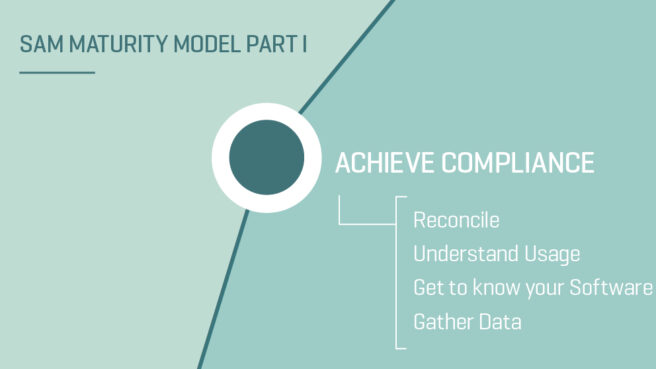The three phases of SAM maturity with Snow – Part I

I’ve been working in this industry over a decade. In that time, Software Asset Management has evolved far beyond achieving license compliance for software purchases – although compliance remains the foundation of SAM and what I will cover in this post. A mature SAM process offers more than a tactical audit defense, it delivers strategic cost control and software optimization opportunities that can be leveraged throughout your business. What I present here is not a formal model, but a process based on my experience with customers and the typical journey you embark upon as you implement SAM in your organization. So, let’s focus on those first crucial 120 days of your SAM process with Snow, and what you can expect to achieve within that time.
Phase one – achieve compliance
Gather DATA
Few organizations have absolute zero Software Asset Management (SAM). Companies identify a need for software, purchase it, deploy it, use it, and manage it, and eventually retire it. Managing the licenses associated with the software life cycle can be ad-hoc and disjointed, with responsibilities spread across the business – presenting a challenge. As licensing models become more complex as technology speeds up and cloud capabilities present new opportunities for vendors to generate revenue, a systematic approach to managing software assets has become imperative and impossible without technology.
Regardless of what SAM solution you use, it must be populated with data. And that data needs to reflect what software has been purchased, where it is installed, who is using it, and how much. The first step for SAM managers is to gather this data, and maintain it to ensure that it remains an accurate reflection of the software.
Unfortunately, the data about software tends to be dispersed, stored in a multitude of tools and platforms, or archived in the heads of a few individuals. It is often patchy and a holistic view of the entire network is rarely attainable. Without tangible, normalized, and historical data to rely on, responding to a software audit will be challenging and likely to be highly costly.
Getting to the point where your SAM solution can provide you with actionable intelligence that will support you during an audit is a manual fact-finding mission that requires collaboration with multiple stakeholders across the business. But it is a critical first step.
Get to KNOW YOUR software
Within the first month following technical implementation of Snow, the solution will provide you with that all-important holistic view – or inventory in SAM speak – of your estate. You will gain insight into what software is deployed, and where.
That holistic view includes servers, laptops, workstations, desktops, terminal servers, datacenters, virtualized environments, hypervisors, mobile tablets, and smartphones, on-premise and in the cloud. These discovered entities are scanned for information about the software installed on them, who is using it, and how much. Naturally, discovery and inventory need to be carried out regularly – daily for most organizations – to ensure that new devices, installs, and configuration changes are picked up.
Processed by Snow’s Software Recognition Service, the raw inventory data is normalized into intelligible software titles, identifying installed suites, bundles, standalone products, and any up- or downgrade rights. Data normalization ensures that naming is consistent for all applications, regardless of how they are deployed or installed.
At this point, the daily changes to your environment are picked up automatically, building a history of your installations over time. You are beginning to gain an understanding of what is on your network.
UNDERSTAND USAGE
After working with Snow for about 90 days you will have reached a significant degree of SAM maturity. Many software vendors consider 90-days usage history a critical breaking point in relation to license optimization, re-allocation, and reassignments.
Snow not only gathers information about software installations (what and where), the solution also retrieves information about who is using it and how much – every day. By comparing installations with usage, SAM managers can make informed decisions on the actual need for software, removing or reassigning unused software. Accurate usage data gathered over time enables SAM managers to forecast need based on facts, facilitating internal negotiations for additional software purchases, purchase of volume-licensing agreements, and audits.
RECONCILE
Reconciliation harmonizes contract, purchase, and entitlement information with normalized inventory data to establish an Effective License Position (ELP) — the balance of purchased to consumed software. In practice, reconciliation requires you to add license information into Snow License Manager and assign it to users, machines, or organizational units – depending on the metric of the application.
License information is extensive, including fields such as the number of licenses purchased, cost, additional use rights (such as cross-edition), maintenance and support contracts, and who/ what the license is assigned to. The accuracy of this process forms the basis of compliance, risk reduction, audit defense, contract negotiations, license true ups and optimizing software spend.
Following Snow’s best practice for implementing Snow License Manager, at about 120 days into the project you should achieve reconciliation for your top vendors. This is the point where you gain control over your compliance position and are audit ready. It’s time to breathe out.
In part II, I talk about the second two phases of SAM maturity: leveraging SAM intelligence to benefit many other parts of your business, and the role of automation to manage time-consuming tasks, leaving you to focus on what matters.